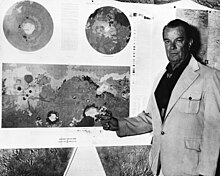
Apollo 17 was the eleventh and final mission of NASA's Apollo program, the sixth and most recent time humans have set foot on the Moon or traveled beyond low Earth orbit. Commander Gene Cernan and Lunar Module Pilot Harrison Schmitt walked on the Moon, while Command Module Pilot Ronald Evans orbited above. Schmitt was the only professional geologist to land on the Moon; he was selected in place of Joe Engle, as NASA had been under pressure to send a scientist to the Moon. The mission's heavy emphasis on science meant the inclusion of a number of new experiments, including a biological experiment containing five mice that was carried in the command module.

Mare Cognitum is a lunar mare located in a basin or large crater which sits in the second ring of Oceanus Procellarum. To the northwest of the mare is the Montes Riphaeus mountain range, part of the rim of the buried crater or basin containing the mare. Previously unnamed, the mare received its name in 1964 in reference to its selection as the target for the successful impact probe Ranger 7, the first American spacecraft to return closeup images of the Moon's surface.

Mare Serenitatis is a lunar mare located to the east of Mare Imbrium on the Moon. Its diameter is 674 km (419 mi).

Alphonsus is an ancient impact crater on the Moon that dates from the pre-Nectarian era. It is located on the lunar highlands on the eastern end of Mare Nubium, west of the Imbrian Highlands, and slightly overlaps the crater Ptolemaeus to the north. To the southwest is the smaller Alpetragius. The crater name was approved by the IAU in 1935.

Harold (Hal) Masursky was an American astrogeologist.

Brayley is a lunar impact crater located in the southwest part of the Mare Imbrium. It was named after British geographer Edward W. Brayley in 1935. It has a circular rim and a low rise in the center. There are no notable craters overlapping the rim or interior. The sinuous rille Rima Brayley passes to the north of Brayley.

Al-Khwarizmi is a lunar impact crater located on the far side of the Moon. It lies to the southeast of the crater Moiseev, and northeast of Saenger.

Proclus is a young lunar impact crater located to the west of the Mare Crisium, on the east shore of the Palus Somni. Its diameter is 27 km. It was named after 5th century Greek mathematician, astronomer and philosopher Proclus.

Littrow is a lunar impact crater that is located in the northeastern part of the Moon's near side, on the east edge of Mare Serenitatis. Its diameter is 29 km. The crater is named after Bohemian astronomer Joseph Johann von Littrow (1781–1840). Some distance to the northeast is the prominent crater Römer, while to the south is Vitruvius.
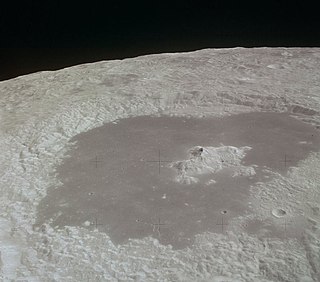
Tsiolkovskiy is a large lunar impact crater that is located on the far side of the Moon. Named for Russian scientist Konstantin Tsiolkovsky, it lies in the southern hemisphere, to the west of the large crater Gagarin, and northwest of Milne. Just to the south is Waterman, with Neujmin to the south-southwest. The crater protrudes into the neighbouring Fermi, an older crater of comparable size that does not have a lava-flooded floor.

Planetary geology, alternatively known as astrogeology or exogeology, is a planetary science discipline concerned with the geology of celestial bodies such as planets and their moons, asteroids, comets, and meteorites. Although the geo- prefix typically indicates topics of or relating to Earth, planetary geology is named as such for historical and convenience reasons; due to the types of investigations involved, it is closely linked with Earth-based geology. These investigations are centered around the composition, structure, processes, and history of a celestial body.

The Astrogeology Science Center is the entity within the United States Geological Survey concerned with the study of planetary geology and planetary cartography. It is housed in the Shoemaker Building in Flagstaff, Arizona. The Center was established in 1963 by Eugene Merle Shoemaker to provide lunar geologic mapping and to assist in training astronauts destined for the Moon as part of the Apollo program.

The Cayley Formation is a discontinuous unit of plains-forming material on the Moon. It was first recognized in the central near side of the Moon in 1965, by the Astrogeology group of the United States Geological Survey. It was previously mapped as part of the Fra Mauro formation. During the Apollo era, the formation was mapped in many other parts of the Moon including the far side

Taurus–Littrow is a lunar valley located on the near side at the coordinates 20.0°N 31.0°E. It served as the landing site for the American Apollo 17 mission in December 1972, the last crewed mission to the Moon. The valley is located on the southeastern edge of Mare Serenitatis along a ring of mountains formed between 3.8 and 3.9 billion years ago when a large object impacted the Moon, forming the Serenitatis basin and pushing rock outward and upward.
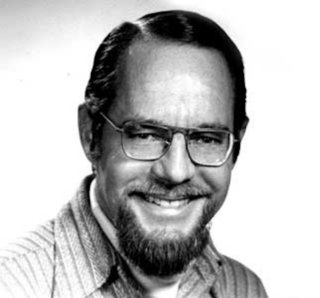
Don Edward Wilhelms is a former United States Geological Survey geologist who contributed to geologic mapping of the Earth's moon and to the geologic training of the Apollo astronauts. He is the author of To a Rocky Moon: A Geologist's History of Lunar Exploration (1993), The geologic history of the Moon (1987), and he co-authored the Geologic Map of the Near Side of the Moon (1971) with John F. McCauley. Wilhelms also contributed to Apollo Over the Moon: A View from Orbit. He has also contributed to the study of Mars, Mercury, and Ganymede.

Victory is a feature on Earth's Moon, a crater in Taurus–Littrow valley. Astronauts Eugene Cernan and Harrison Schmitt visited it in 1972, on the Apollo 17 mission, during EVA 2. The astronauts stopped at the south rim of Victory on their way back to the Lunar Module from Shorty crater.
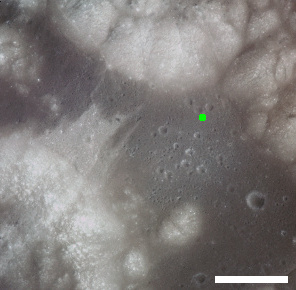
Van Serg is a feature on Earth's Moon, a crater in Taurus–Littrow valley. Astronauts Eugene Cernan and Harrison Schmitt visited it in 1972, on the Apollo 17 mission, during EVA 3. Van Serg was designated Geology Station 9.
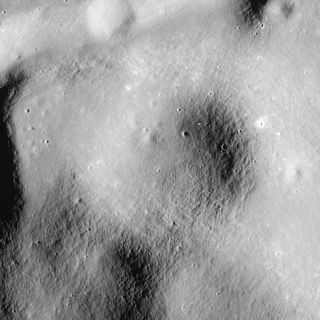
St. George is a feature on Earth's Moon, a crater in the Hadley–Apennine region. Astronauts David Scott and James Irwin drove their rover onto what was suspected to be its ejecta blanket in 1971, on the Apollo 15 mission, during EVA 1. They collected samples to the northeast of the crater, at Geology Station 2 of the mission.

Baerbel Kösters Lucchitta is a scientist emeritus at the Astrogeology Science Center at the USGS and one of the first women in the field of Astrogeology. She was one of the people responsible of making lunar maps for the Apollo 11 mission. During her career, she was dedicated to mapping the Moon, Mars, Europa and the Galilean Satellites, and Antarctica. The Lucchitta Glacier is named after her work in Antarctica, and the Asteroid 4569 Baerbel is named after her work in planetary geology.
